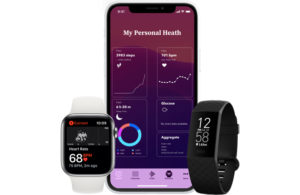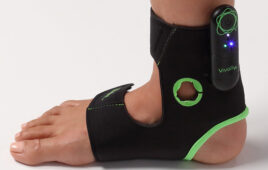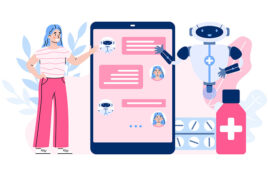The COVID-19 pandemic has made wearable medical devices more important than ever, with more companies turning to trade secret law for protection.
Xavier M. Brandwajn, Kurt A. Kappes, and Katie Tipper-McWhorter, Greenberg Traurig

Researchers at Stanford University are even studying the use of wearables to spot COVID-19 before symptoms set in. [Image courtesy of Stanford University]
This impressive growth is not surprising considering recent societal changes that have increased the demand for wearables. Even before COVID-19, the fitness trend in many areas saw individuals tracking their biometric data on a daily basis. Now, with many fitness centers closed and the workforce largely working from home as a result of the pandemic, wearables provide a useful solution. And, given the looming risk of COVID-19 exposure, patients tend to prefer wearables and telehealth options over in-office visits.
In the medical research context, there’s even a study at Stanford University that is focused on the connection between the data tracked by wearables — in particular, a wearer’s heart rate, skin temperature, and blood oxygen saturation — and pre-symptom, predictive diagnoses of COVID-19.
Patent versus trade secret protection
These trends not only increase the value of intellectual property in wearables, but also the risk of intellectual property theft. The algorithms, software requirement specifications, and other technical know-how in wearables are integral to reading biometric data and detecting symptoms. The valuable features and functions in wearables also reflect “negative know-how,” notably what clinical trials and tests have revealed does not work.
Recent court decisions — on the viability of software and other technologies as eligible subject matter for patent applications, and on the propriety of inter partes reviews for challenging issued patents — as well as not insignificant filing and maintenance costs have made patents a less attractive proposition for companies in the wearables industry, and accordingly, more companies have turned to trade secret law for protection.
Recent court decisions
Recent cases in the wearables and related industries provide helpful guidance. For example, in Jawbone v. Fitbit , Inc. (Case No. CGC 15-546004), a California state Superior Court case in San Francisco that ultimately settled on Dec. 8, 2017, Jawbone alleged that Fitbit solicited former employees who, on their last days of employment, stole proprietary company information that Jawbone characterized as “an intricate roadmap into the core of [its wearables] business…and the future direction of Fitbit’s main competitor. Further, in a recent International Trade Commission (ITC) investigation involving allegations of misappropriated trade secrets involving botox products, the Administrative Law Judge (ALJ), in his Final Determination, reaffirmed that the ITC has broad subject matter jurisdiction over trade secrets both developed and misappropriated outside the United States.vThe ALJ held that the ITC’s jurisdiction reaches alleged misappropriation of a Korean company’s Korean trade secrets based on activity solely in Korea by another Korean company, so long as infringing products are imported into the United States. The act of importation alone, the ALJ ruled, is sufficient to confer jurisdiction, and it is irrelevant whether the asserted trade secrets are United States-based intellectual property rights.
What to watch
Important lessons emerge from the trends and cases discussed above:
- The increased demand and the projected market value growth make the trade secrets associated with wearables more valuable and more deserving of robust protection.
- Because the intellectual property in wearables often reflects the collaboration of healthcare and tech companies, carefully tailored non-disclosure agreements and procedures for the exchange and treatment of confidential information are crucial to protect trade secrets.
- With many employees working from home, and likely to do so for the foreseeable future, the Legal, Information Technology, and Human Resources departments of companies in the wearables space should coordinate a comprehensive reassessment of their employment agreements, technological platforms and tools, and internal policies regarding the creation, use, and protection of sensitive data to prevent, or at a minimum detect as early as possible, any potential breaches by current or former employees.
- Given the expansive reach of certain venues like the ITC in regards to trade secret misappropriation claims, companies should be careful to reassess their protocols, policies, and procedures relating to the protection and use of trade secrets and other confidential information at every level in their design, production, and supply chains — even if certain events occur outside the United States.

Xavier Brandwajn, Greenberg Traurig
Xavier Brandwajn is a shareholder at Greenberg Traurig. He represents Silicon Valley and international clients in high-stakes patent disputes and other intellectual property matters in federal and state courts, as well as before the International Trade Commission (ITC) and in arbitration. Brandwajn has deep experience representing technology companies of all sizes in patent, trade secret, copyright, trademark, and complex commercial disputes, from inception through trial.

Kurt A. Kappes, Greenberg Traurig
Kurt A. Kappes is the managing shareholder of Greenberg Traurig’s Sacramento office and co-chair of the firm’s Labor & Employment Practice’s Complex Employment Litigation & Trials group. He has extensive experience in advising and representing clients on issues involving trade secrets and employee mobility, computer fraud, non-competes, and unfair competition.

Katie Tipper-McWhorter, Greenberg Traurig
Katie Tipper-McWhorter is an associate at Greenberg Traurig in Houston. She focuses her practice on complex commercial litigation. Katie has wide-ranging experience handling cases involving alleged breaches of contract, breaches of fiduciary duties, fraud, misrepresentation, non-disclosure agreements, trade secrets, and non-compete agreements. She regularly handles contract claims, construction claims, DTPA claims, and matters related to professional liability.
This article reflects the opinions of the authors, and not of Greenberg Traurig or Medical Design & Outsourcing. The article is presented for informational purposes only and it is not intended to be construed or used as general legal advice nor as a solicitation of any type.




